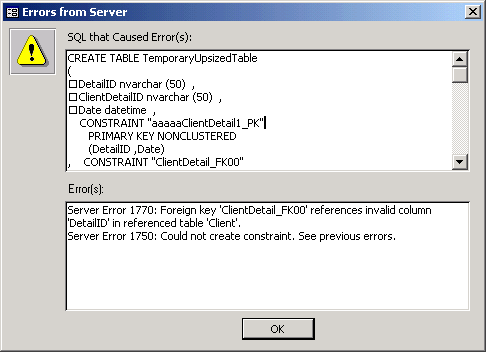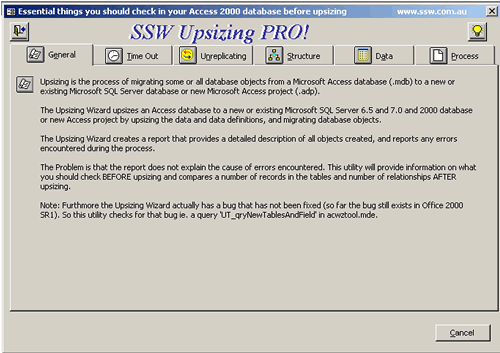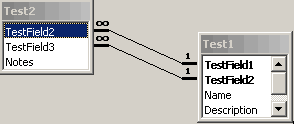Tales from the Battle Field
This article
refers to one of several problems I came across when attempting to upsize
from Access 2000 to SQL Server. Hopefully, you will pick up a few tips
that will save you a heap of time.
There are
3 things I will discuss:
1. Microsoft Access 2000 Upsizing Wizard
2. SQL Server 7 and 2000 DTS (Data Transformation Services)
3. SSW Upsizing PRO!
When transferring
data from Access to SQL Server, most people use and recommend using SQL
Server DTS because the Microsoft Upsizing Wizard does have its problems.
By the end of this article, you will see that the Microsoft Upsizing Wizard
has a place equal or greater than DTS in this transfer process.
Before starting
you can check out these links and read this article from Microsoft http://www.microsoft.com/SQL/techinfo/migrate.htm.
A plethora of articles are also at http://www.ssw.com.au/ssw/upsizingpro/frmLinks.htm
BUT STOP! Don't follow those links! It will take you at least a week to
understand and check all that stuff. I recommend using the Microsoft Upsizing
Wizard, and SSW Upsizing PRO! which will only take 5 minutes to understand,
and a few hours to implement.
Only a few days...
Let me tell
you about a situation I encountered a while ago (Names changed of course).
I was working for a very short-tempered man (ST for short), CEO of Backyard
Accounting Corporation. He wanted his 100MB database moved to SQL Server.
He told us that he just didn't have time for a long-winded conversion
process. Upon further investigation I discovered that his database was
stitched together by his son, Mr ST Junior - so that the company could
save money.
Mr ST called
me in the office and said "Can you start transfering the data? My
son has heard on the newsgroups that SQL Server DTS is the way to go."
I say "Fine".
Ho hum, I
sit down and take a look at Mr ST's database - the usual assortment of
Clients, Accounts and Invoices. Yawn. This is going to be a walk in the
park.
An hour or
so later I see Mr ST with my conversion schedule in hand. We go through
it together:
I tell Mr
ST that it shouldn't take more than a day to convert the database. He
grins, and his gold teeth light up the room.
I add "Unless
there are problems of course." I get that ghastly look but he says
"Excellent! Begin the conversion process. I will tell my workers
that they will be off-line tomorrow."
A few days
later, I am sweating like a pig at 3:00am in the morning. I have given
up on DTS, as it constantly gave errors that I just could not isolate.
I have also discovered that it doesn't transfer the hundreds of relationships
- maybe I should have made time to read through the 50+ page articles
on Microsoft's esteemed web site. Mr ST is getting very upset. What can
I do?
Microsoft Upsizing Wizard
I tell Mr
ST that Microsoft also has an Upsizing Wizard. He sounds impressed and
I decide to take that approach.

Unfortunately
there were also problems with the Microsoft Upsizing Wizard. It turns
out the conversion process of a backend Access mdb to SQL server is no
small task if you have a database any more complicated than Northwind
(which Microsoft must have done all their testing on).
Please Give me an Explanation
Access and
SQL Server talk the same language most of the time... Most
of the common field types can are translated fine. For example, a "Memo"
field in Access would be a "Text" field in SQL Server. Most relationships
translate 1:1 from Access to SQL Server.
However,
there are subtle differences between the two. The "Text" fields in Access
can only be 255 characters long, whereas the equivalent data types of
"Varchar" and "Nvarchar" can store 8000 and 4000 characters respectively.
Another element of difference is that Access and SQL Server have different
default behaviours. For example, by default, Microsoft Access disallows
fields with blank strings i.e. "Allow Zero Length" = No. However, SQL
Server allows such fields by default. Differences like these have to be
kept in mind on the winding road to upsizing heaven.
Please
give me a solution
So wouldn't
it be good if there was a utility that would tell you all the things in
your Access database, that are going to cause SQL Server problems.
Aka cause the Microsoft Upsizing Wizard to fall over. Well there is. It
is called SSW Upsizing PRO! available at www.ssw.com.au
Today I use
SSW Upsizing PRO! whenever I start an upsizing job. The report it generates
gives me a quick idea of how complicated this job is going to be in the
first place. It incorporates the recommendations of many upsizing documents
into one easy-to-use utility. It also compares your old mdb file with
the newly upsized SQL Server database so that you can be assured that
the conversion was accurate. Read on to find out more about making an
'upsizing' as painless as possible.

As much as
we love the Microsoft Access 2000 Upsizing Wizard, it still has deficiencies.
These range from missing constraints to complete tables being skipped
without any significant warnings. SSW Upsizing PRO! highlights these problems,
so you can be prepared for such issues. These problems include (but are
not limited to):
- The Microsoft
Upsizing Wizard allows tables without unique constraints. Tables with
this problem cannot be modified.
- SQL Server
and the Microsoft Upsizing Wizard allow spaces in table and field names
(e.g. "Order Details"), but this is not a good idea.
- Validation
rules are not upsized.
- If a unique
index is set on a field, and the required property is set to "No"
in Access, the Microsoft Upsizing Wizard will fail.
- If you
have created a table and then reordered the fields after you have saved
it (everybody does this), the Microsoft Upsizing Wizard will often fall
over.
- Multiple
Key Foreign Key Relationships on tables that map to fields of a different
name will fail. (As below)

- Tables
with invalid dates will be skipped without warning (SQL Server smalldatetime
can only store from the years 1900 to 2079. Dates outside this range
will fail.) For example, Access will allow data entry errors such as
'1/1/199'.
- Fields
with multiple-key indexes cannot be upsized if the total size of the
fields adds to more than 450 characters.

Running SSW Upsizing PRO!
All
you need to do is to select the data .mdb file and it will give you a
report on all problems that need to be fixed. For example, it will inform
you of the columns with invalid dates, and how to isolate the culprit
records. After upsizing, it will compare the SQL Server Database, so you
can be assured that your data and all relationships have been transferred
correctly.
DTS is still useful, but...
I
wouldn't use DTS to upsize my data to SQL Server, because it doesn't convert
relationships, and is not as robust with some data types, such as time
and date fields. But it is still useful for diagnosing problems with data.
For example, suppose you have a table that will not upsize with the Microsoft
Upsizing Wizard. If there is a problem, it will skip the data, and sometimes
the remaining table structures as well. What is really useful is that
you can use DTS to find the problem by telling you the line number where
it is falling over, so you can correct the erroneous data.
However,
it is not useful for importing time-related data. See DTS
Horror Stories for more detailed information on the example problem.
Conclusion
Sometimes
you wish you had the time to build the database schema from scratch! This
is not practical in the majority of cases, and this is where the SSW Upsizing
PRO! fills the gap - to tell you the problems that exist in you mdb file,
to make your experience with the Microsoft Upsizing Wizard as smooth as
possible.
For a seamless
transition from Access to SQL Server, the Developer has to use many tools
to:
- Isolate
bad data (usually date data)
- Find
structural problems (the source of most errors)
- Counter
problems in the official Upsizing tools provided by Microsoft.
These tools
include:
- SSW Upsizing
PRO!
- Microsoft
SQL Server DTS
- Cutting
and Pasting in Microsoft Access
With the
deficiencies of DTS in mind, the Microsoft Upsizing Wizard is your best
overall solution to upsizing. I recommend using the Microsoft Upsizing
Wizard as your primary tool, with DTS as an ancillary tool for troubleshooting
minor problems. In summary, use SSW Upsizing PRO! in conjunction with
the Microsoft Upsizing Wizard for a relatively hassle-free upsizing process.
Of course, Mr TW will be much happier!
Without
these tools, there is a steep hill to climb, particularly when you are
faced with the upsize of a large and/or complicated legacy Access database.
Adam
Cogan and David Klein
December 2000